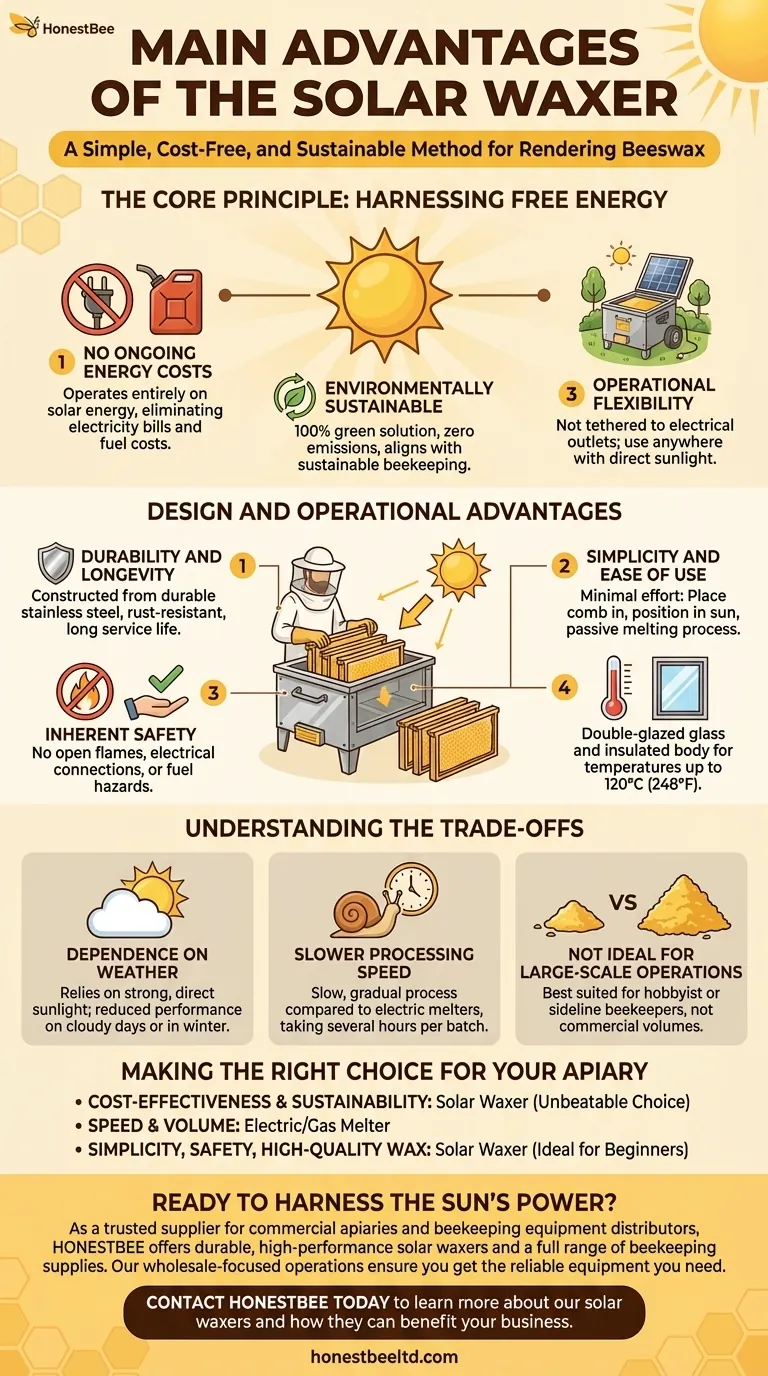At its core, a solar waxer offers beekeepers a remarkably simple and cost-free method for rendering beeswax. It leverages the natural power of the sun to melt and purify wax from old combs, cappings, and hive scrapings without requiring electricity, gas, or constant supervision. This makes it an exceptionally safe, sustainable, and efficient tool for processing wax on a small to medium scale.
The primary advantage of a solar waxer is its ability to transform a necessary beekeeping chore into a passive, set-it-and-forget-it process. By eliminating energy costs and complex machinery, it provides a highly effective, safe, and environmentally friendly solution for rendering high-quality beeswax.

The Core Principle: Harnessing Free Energy
The most significant advantage of a solar waxer is its power source: the sun. This fundamental design choice leads to several key benefits that define its value proposition.
No Ongoing Energy Costs
A solar waxer operates entirely on solar energy, meaning there are no electricity bills or fuel costs associated with its use. Once the initial investment is made, the operational cost is zero, making it a highly economical tool over its lifetime.
Environmentally Sustainable
By using a renewable energy source, the solar waxer is a 100% green solution. It produces no emissions and reduces the beekeeper's carbon footprint, aligning perfectly with the sustainable nature of beekeeping itself.
Operational Flexibility
Since it is not tethered to an electrical outlet, a solar waxer can be used anywhere with direct sunlight. This flexibility is ideal for beekeepers with apiaries in remote locations or those who simply wish to process wax outdoors.
Design and Operational Advantages
The physical construction and simple operation of solar waxers contribute directly to their reliability and ease of use.
Durability and Longevity
Most high-quality solar waxers are constructed from durable stainless steel. This material is resistant to rust, easy to clean, and can withstand the high temperatures and outdoor conditions, ensuring a long and reliable service life.
Simplicity and Ease of Use
The process is incredibly straightforward: place the old comb in the melter, position it in the sun, and let the heat do the work. This minimal effort makes it an ideal tool for beginners and experienced beekeepers who value efficiency.
Inherent Safety
The absence of electrical connections, open flames, or combustible fuels makes the solar waxer exceptionally safe. This eliminates the risks of fire or electrical shock that can be associated with other melting methods.
High-Efficiency Heat Capture
Modern designs often feature high-strength, double-glazed glass and an insulated body. This design traps solar radiation effectively, allowing internal temperatures to reach up to 120°C (248°F), ensuring a thorough and efficient melt. The result is clean wax that separates naturally from debris.
Understanding the Trade-offs
While highly effective, the solar waxer's design comes with inherent limitations that are important to consider.
Dependence on Weather
The most obvious trade-off is its complete reliance on strong, direct sunlight. Its performance is significantly reduced on cloudy days, and it is unusable at night or during winter months in many climates.
Slower Processing Speed
Compared to electric melters, the solar method is a slow and gradual process. It can take several hours to render a single batch, which may not be suitable for beekeepers needing to process large volumes of wax quickly.
Not Ideal for Large-Scale Operations
Due to its batch size and dependence on the sun, the solar waxer is best suited for hobbyist or sideline beekeepers. Commercial operations with hundreds of hives would likely find its capacity insufficient for their needs.
Making the Right Choice for Your Apiary
Ultimately, the decision to use a solar waxer depends on your specific goals, scale, and climate.
- If your primary focus is cost-effectiveness and sustainability: The solar waxer is an unbeatable choice, eliminating all ongoing energy costs.
- If your primary focus is processing large volumes of wax rapidly: An electric or gas-powered melter will provide the speed and consistency you need.
- If your primary focus is simplicity, safety, and high-quality wax: The solar waxer's gentle, passive melting process is ideal, especially for beginners.
It stands as a testament to elegant design, providing an effective solution that works in harmony with the natural environment.
Summary Table:
| Advantage | Key Benefit |
|---|---|
| No Energy Costs | Operates on free solar power, eliminating electricity or fuel bills. |
| Eco-Friendly | 100% green, renewable energy source with zero emissions. |
| Operational Flexibility | Can be used anywhere with direct sunlight, even in remote apiaries. |
| Durability & Safety | Stainless steel construction; no fire or electrical hazards. |
| Simplicity | Minimal effort required; ideal for beginners and experienced beekeepers. |
Ready to harness the sun's power for your beekeeping operation?
As a trusted supplier for commercial apiaries and beekeeping equipment distributors, HONESTBEE offers durable, high-performance solar waxers and a full range of beekeeping supplies. Our wholesale-focused operations ensure you get the reliable equipment you need to process wax efficiently and sustainably.
Contact HONESTBEE today to learn more about our solar waxers and how they can benefit your business.
Visual Guide

Related Products
- Professional Stainless Steel Wax Melter for Beekeeping and Crafts
- Beeswax Melter for Candle Making Honey Bee Wax Melter
- Steam Beeswax Melter Wax Warmer for Wax Processing
- Electric Beeswax Flat Sheet Machine with Operating Tray for Wax Processing
- Manual Beeswax Flat Sheet Machine for Beeswax Processing
People Also Ask
- How long does the wax melting process typically take? A Guide to Safe & Efficient Melting
- What are wax melters used for? Unlock Efficient Wax Processing for Your Business
- What is the flash point of beeswax, and why is it important? Essential Safety Guide for Beekeepers
- How do you pour melted beeswax into a mold? A Step-by-Step Guide for a Flawless Finish
- What temperature range is considered gentle heat for melting beeswax? Preserve Aroma & Color



















